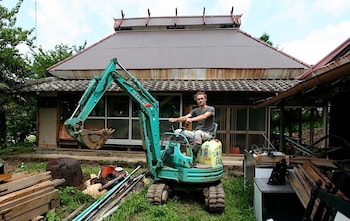Buying a property is likely one of the most expensive decisions you’ll make – even for an experienced property investor, it can be fraught with issues. Making a mistake can cause big repercussions that can cost you money, time and even sink a property chain.
But even the best in the business make the occasional expensive slip-up. We’ve spoken to four property investors and developers, with almost a hundred years of experience between them, about the worst mistakes they’ve made when it comes to buying and renovating a property.
From failed planning permissions turned down to choosing the wrong property entirely, they’ve also passed on what they learnt from their blunders – so you can avoid them.
In 2021, property investor TJ Atkinson bought a listed property in Kent for himself: “I wanted something quirky, with some character that I could make my forever home. It’s in a prime and central location and I knew I could turn it into a beautiful home.”
Despite his experience and contacts, TJ found renovating the property wasn’t easy due to its listed status. He had to wait on several rounds of applications to get planning permission approved, and the initial architect he hired had no listed building experience.
“I was very restricted on what I could do and change within the property, which took away from my desired plans,” he says. “I didn’t fully understand the small, intricate requirements which caused so many delays and significant costs.
“Other refurbishments of this magnitude have cost me £50,000-60,000 previously, whereas this project is forecasted to cost nearly £200,000 due to specialist materials and labourers.”
He estimates that his architect fees alone are £30,000. His advice to others is: “Listed buildings should be left to the experts. It’s an easy way to lose your money. The planning requirements are often more complex and specialist.
“Don’t fall in love with properties. Even residential properties should be solely looked at through investment lenses.”
‘Failing to research my builder cost me double’
TJ also made a mistake with a refurbishment project in Erith, Kent in 2019.
“I saw an opportunity to add value to the property by adding a loft extension,” he says.
But the builder he gave the job to subcontracted the work to another builder who didn’t fully understand what was wanted and, when he did, asked for more money.
“I made a mistake of paying the builder 50pc of the work upfront. When he asked for a further 25pc, two weeks in, I refused, and he walked off the job and refused to complete it.
“As they still had keys, they returned to the property and left the taps on and blocked the bath and sinks, causing the property to flood and ruin the floors and walls.”
TJ had to find another builder to complete the job, meaning it cost him double what he’d expected.
His advice to avoid finding yourself in a similar position?
“Make sure you have contracts with your builders, go and view two or three of their previous jobs, and speak to their previous customers (without the builder present). That way you can find out more about the builder, their attitude, work ethic etc. And don’t pay 50pc upfront.”
In 2016, Jon McCrory bought a house for £70,000 in Salford because it was cheap.
“We’re based in Macclesfield, and the property was in Salford; with traffic, it used to take us 1.5 hours to get there.
“Trying to renovate a property while working full-time is difficult. It becomes much more challenging when it is over an hour away. This was mistake number one.”
Jon said his second mistake was not knowing the area they were buying in.
“We found a cheap house, bought it, renovated it, and rented it out. However, the area in Salford was quite rough – as we soon found out.”
He received a voice message from a police officer one day, telling him that the tenants had been growing a cannabis farm in the house.
“The police had smashed the front door and thrown all the plants and soil in the back garden. The house had holes in the ceiling for ventilation, and they had been bypassing electricity. The house was trashed!
“The biggest reason for this was that we didn’t know the area, and it was 1.5 hours away, so we never did checks on the property.”
The tenants cleaned up the majority of the house but there was still a lot of work to be done and Jon decided to sell up.
“We actually made good money on the sale. However, it wasn’t worth the travelling for two renovations, plus the initial shock of the police calling to tell us they had raided our property was overwhelming,” he says.
“Our advice from this experience to others buying for buy-to-let is: buy close by, know the area, meet your tenants face to face, and do checks on the property every six months. We didn’t do any of the above, and it was an extremely stressful experience.”
Arsh Ellahi has renovated hundreds of properties over the last 25 years, and thought he was on to a winner in 2020 when he came across a place in Wolverhampton that had been taken back to brick.
“I saw the opportunity to add value by converting it into six apartments,” he says. “I purchased the building on the basis that the neighbour had done a renovation and managed to change the windows from wooden sash to UPVC.
“Given that the works had been completed, I ripped out all the wooden windows, ordered the UPVC replacements – only to find a notice slapped to the front of the door from the conservation officer.”
Arsh hadn’t realised the building was Grade II-listed, which meant he couldn’t just copy what his neighbours had done.
“I was told to reinstate the wooden windows, which were almost five times the cost and had to be built back to the original specification. This mistake cost me many thousands of pounds and exceeded the property budget, as well as a lot more delays in the project.”
The renovations took 18 months to complete, and he had to work closely with the heritage officer and reinstate many of the original features in order to bring the building back to use.
“Just because the neighbours have done it, doesn’t necessarily mean that you will also be able to do it. Touch base with the local authority from the outset and ask how they would like the project to be conducted. This gives you the opportunity to come up with various proposals.”
Emma Morby renovates care homes into flats, as well as developing new builds, barn conversions and houses in multiple occupation (HMOs).
In October 2023, she bought a four-bedroom, two-bathroom barn conversion in North Devon.
“Its location is 10 minutes outside of the town, but secluded and peaceful.”
Unfortunately, there wasn’t time to do a full land inspection before completion and this caused problems.
“The land doesn’t drain very well due to the high-density clay, which means it needs a lot more land drainage and soakaways added,” she says. “We have had to wait for summer to sort the land drainage due to not being able to get heavy machinery on site. [Otherwise], it would sink.”
While the land drainage issues have been sorted, they came at an additional cost.
“When buying land, get a land survey (GIS survey),” Emma advises. “Land surveyors measure and map the shape of land; they gather data for civil engineering and construction projects so that accurate site plans can be drawn.
“And get a percolation test so you know how well the land drains and if further additional costs will need to be spent to ensure the land is fit for purpose.”
Disclaimer: The copyright of this article belongs to the original author. Reposting this article is solely for the purpose of information dissemination and does not constitute any investment advice. If there is any infringement, please contact us immediately. We will make corrections or deletions as necessary. Thank you.



